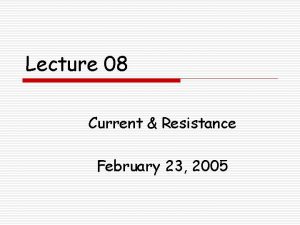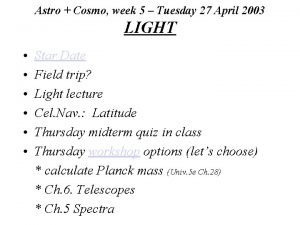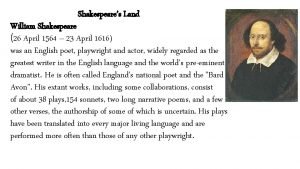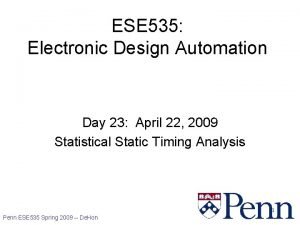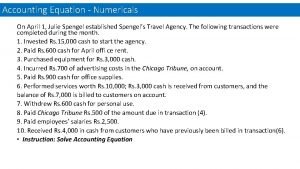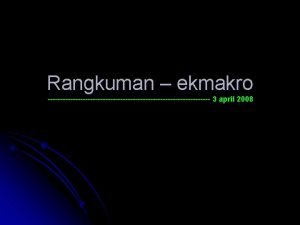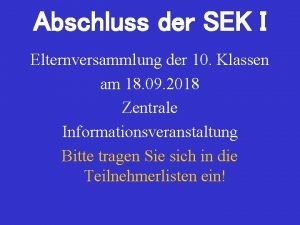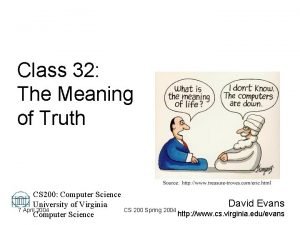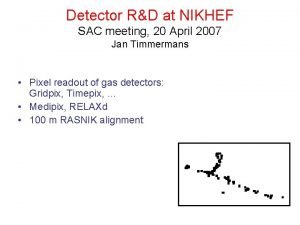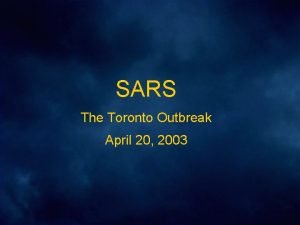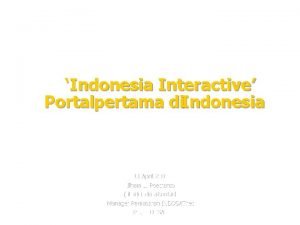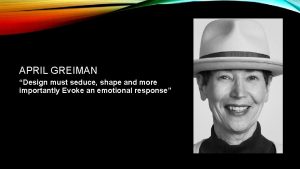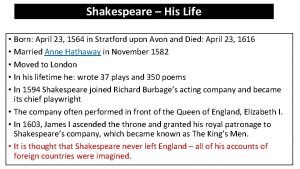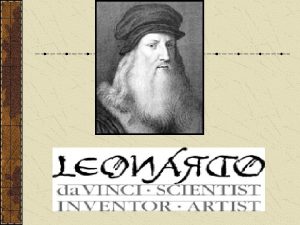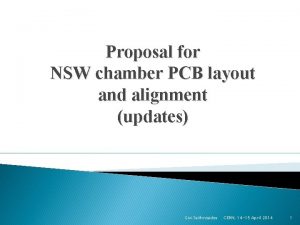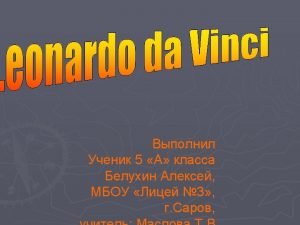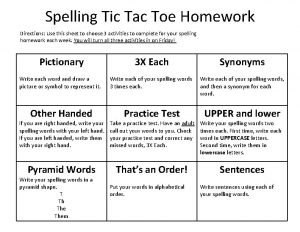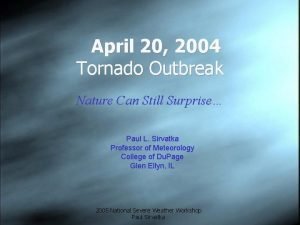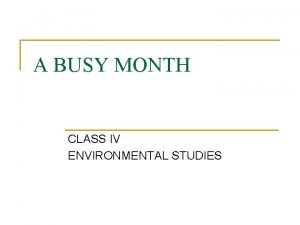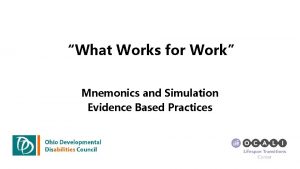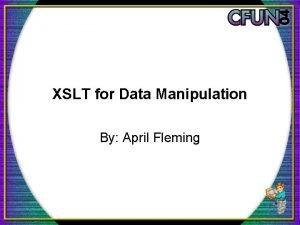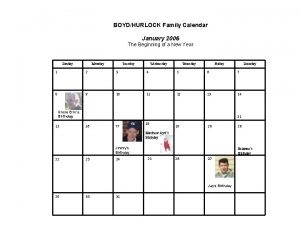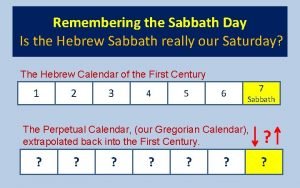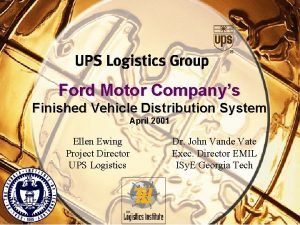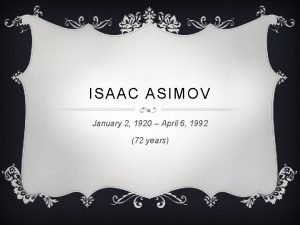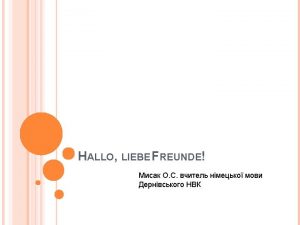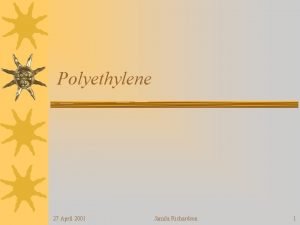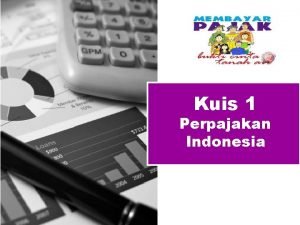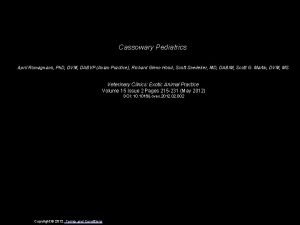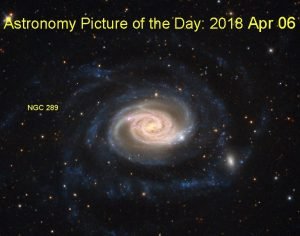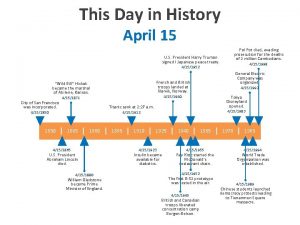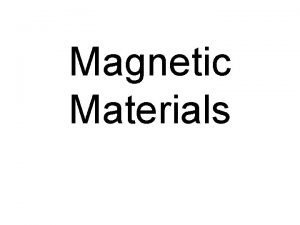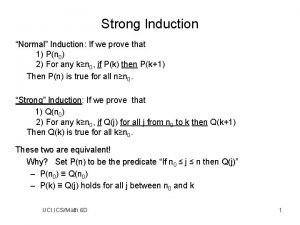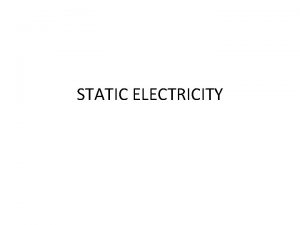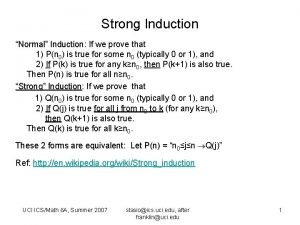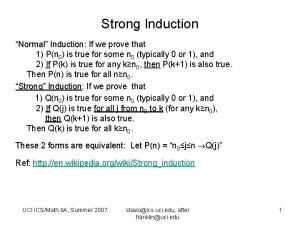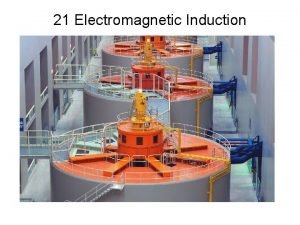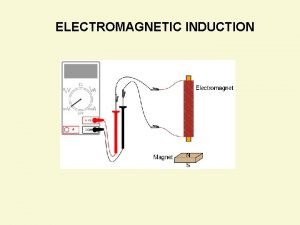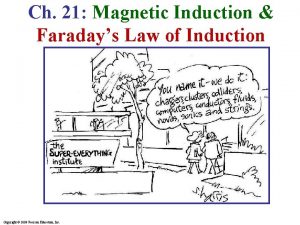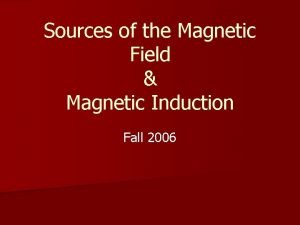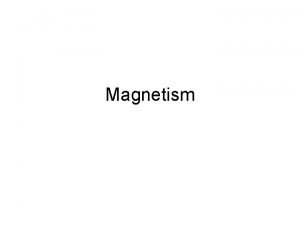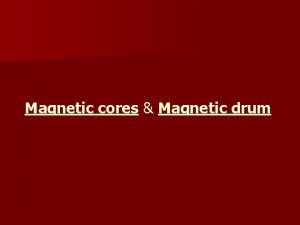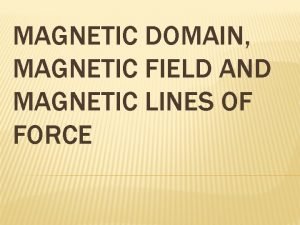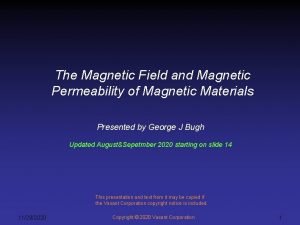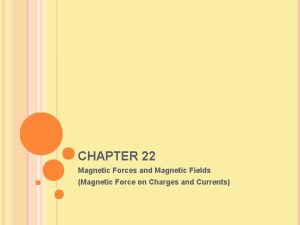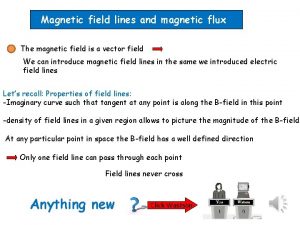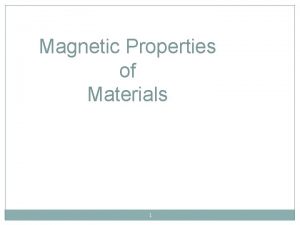Magnetic Induction April 1 2005 Happenings n n





































































- Slides: 69

Magnetic Induction April 1, 2005

Happenings n n n Short Quiz Today New Topic: Magnetic Induction (Chapter 30) Quiz NEXT Friday Exam #3 – April 15 th. Should I do a class on Vectors and how we use them? ? ? [vote]

From The Demo. .

Faraday’s Experiments ? ?

Insert Magnet into Coil

Remove Coil from Field Region

That’s Strange …. . These two coils are perpendicular to each other

Remember Electric Flux? Did you really think you were through with this kind of concept? ? ?

We discussed the normal component of the Electric Field vector q

DEFINITION: Element of Flux through a surface E DA EN OR MA L DF=ENORMAL x DA (a scalar)

“Element” of Flux of a vector E leaving a surface n is a unit OUTWARD pointing vector.

This flux was LEAVING the closed surface q

Definition of TOTAL ELECTRIC FLUX through a surface:

There is ANOTHER Kind of FLUX F THINK OF MAGNETIC FLUX as the “AMOUNT of Magnetism” passing through a surface. Don’t quote me on this!!!

What is thing called FLUX? n Magnetic Flux is a Scalar n The UNIT of FLUX is the q 1 weber = 1 T-m 2 weber

Consider a Loop n xxxxxxxxxxxxxxx xxxxxxxxxxxxxxx n n Magnetic field passing through the loop is CHANGING. FLUX is changing. There is an emf developed around the loop. A current develops (as we saw in demo) Work has to be done to move a charge completely around the loop.

Faraday’s Law (Michael Faraday) n xxxxxxxxxxxxxxx xxxxxxxxxxxxxxx n n For a current to flow around the circuit, there must be an emf. (An emf is a voltage) The voltage is found to increase as the rate of change of flux increases.

Faraday’s Law (Michael Faraday) xxxxxxxxxxxxxxx xxxxxxxxxxxxxxx We will get to the minus sign in a short time.

Faraday’s Law (The Minus Sign) xxxxxxxxxxxxxxx xxxxxxxxxxxxxxx Using the right hand rule, we would expect the direction of the current to be in the direction of the arrow shown.

Faraday’s Law (More on the Minus Sign) xxxxxxxxxxxxxxx xxxxxxxxxxxxxxx The minus sign means that the current goes the other way. This current will produce a magnetic field that would be coming OUT of the page. The Induced Current therefore creates a magnetic field that OPPOSES the attempt to INCREASE the magnetic field! This is referred to as Lenz’s Law.

How much work? xxxxxxxxxxxxxxx xxxxxxxxxxxxxxx f m e A magnetic field an electric field are intimately connected. )

So. . FARADAY’s LAW

Flux The MAGNITUDE of the emf induced in a loop is equal to the negative of the rate at which the magnetic flux through the loop changes with time.

Flux Can Change n n If B changes If the AREA of the loop changes Changes cause emf s and currents and consequently there are connections between E and B fields These are expressed in Maxwells Equations

Maxwell’s Equations (Next Course. . Just a Preview!) Gauss Faraday

Another View Of That damned minus sign again …. . SUPPOSE that B begins to INCREASE its MAGNITUDE INTO THE PAGE xxxxxxxxxxxxxxx xxxxxxxxxxxxxxx n n n The Flux into the page begins to increase. An emf is induced around a loop A current will flow That current will create a new magnetic field. THAT new field will change the magnetic flux.

Lenz’s Law Induced Magnetic Fields always FIGHT to stop what you are trying to do! i. e. . . Murphy’s Law for Magnets

Example of Nasty Lenz The induced magnetic field opposes the field that does the inducing!


Don’t Hurt Yourself! The current i induced in the loop has the direction such that the current’s magnetic field Bi opposes the change in the magnetic field B inducing the current.

Take a deep breath!!

Lenz’s Law An induced current has a direction such that the magnetic field due to the current opposes the change in the magnetic flux that induces the current. (The result of the negative sign!) … OR The toast will always fall buttered side down!

An Example The field in the diagram creates a flux given by FB=6 t 2+7 t in milli. Webers and t is in seconds. (a) What is the emf when t=2 seconds? (b) What is the direction of the current in the resistor R?

This is an easy one … Direction? B is out of the screen and increasing. Current will produce a field INTO the paper (LENZ). Therefore current goes clockwise and R to left in the resistor.

Figure 31 -36 shows two parallel loops of wire having a common axis. The smaller loop (radius r) is above the larger loop (radius R) by a distance x >> R. Consequently, the magnetic field due to the current i in the larger loop is nearly constant throughout the smaller loop. Suppose that x is increasing at the constant rate of dx/dt = v. (a) Determine the magnetic flux through the area bounded by the smaller loop as a function of x. (Hint: See Eq. 30 -29. ) In the smaller loop, find (b) the induced emf and (c) the direction of the induced current. v

This combines some stuff and is a good review for the final! Or Not. B is assumed to be constant through the center of the small loop and caused by the large one. q

The calculation of Bz q

More Work In the small loop: dx/dt=v

Which Way is Current in small loop expected to flow? ? B q

What Happens Here? n n n Begin to move handle as shown. Flux through the loop decreases. Current is induced which opposed this decrease – current tries to re-establish the B field.

moving the bar

Moving the Bar takes work v

What about a SOLID loop? ? Energy is LOST BRAKING SYSTEM METAL Pull

Back to Circuits for a bit ….

Definition Current in loop produces a magnetic field in the coil and consequently a magnetic flux. If we attempt to change the current, an emf will be induced in the loops which will tend to oppose the change in current. This this acts like a “resistor” for changes in current!

Definition of Inductance L UNIT of Inductance = 1 henry = 1 T- m 2/A FB is the flux near the center of the coil

Consider a Solenoid l n turns per unit length

So…. Depends only on geometry just like C and is independent of current.

Inductive Circuit n i n n Switch to “a”. Inductor seems like a short so current rises quickly. Field increases in L and reverse emf is generated. Eventually, i maxes out and back emf ceases. Steady State Current after this.

Consider a “uniform short” coil

From before

THE BIG INDUCTION n n As we begin to increase the current in the coil The current in the first coil produces a magnetic field in the second coil Which tries to create a current which will reduce the field it is experiences And so resists the increase in current.

Trying to make an equation out of this…. .

Back to the real world… Switch to “a” i

Solution

Switch position “b”

Max Current Rate of increase = max emf

. n o ti he t e v l So p o o l ua q e

IMPORTANT QUESTION n n n Switch closes. No emf Current flows for a while It flows through R Energy is conserved (i 2 R) WHERE DOES THE ENERGY COME FROM? ?

For an answer Return to the Big C n E=e 0 A/d n n +dq +q -q n We move a charge dq from the (-) plate to the (+) one. The (-) plate becomes more (-) The (+) plate becomes more (+). d. W=Fd=dq x E x d

The calc The energy is in the FIELD !!!

What about POWER? ? power to circuit Must be d. WL/dt power dissipated by resistor

So Energy stored in the Capacitor

WHERE is the energy? ? l

Remember the Inductor? ? ? ? ? ? ?


ENERGY IN THE FIELD TOO!

IMPORTANT CONCLUSION n n A region of space that contains either a magnetic or an electric field contains electromagnetic energy. The energy density of either is proportional to the square of the field strength.

 Chapter 23 electric current circuit happenings
Chapter 23 electric current circuit happenings Wb flux
Wb flux Magnetic permeability of materials
Magnetic permeability of materials Magnetic moment and magnetic field relation
Magnetic moment and magnetic field relation Force on a charged particle
Force on a charged particle January february march april may
January february march april may 27 april 2003
27 april 2003 Kenn nesbitt halloween poems
Kenn nesbitt halloween poems Bondservants motorcycle
Bondservants motorcycle 23 april 1564
23 april 1564 9/11 sonnet
9/11 sonnet April raintree summary
April raintree summary April kindergarten newsletter
April kindergarten newsletter 535 days before 23 april
535 days before 23 april Falske computer timeshare company
Falske computer timeshare company 3 april 2008
3 april 2008 The morning night april
The morning night april When in april the sweet showers fall
When in april the sweet showers fall 11. april
11. april Meaning
Meaning April rustianto
April rustianto Wetter paris anfang juni
Wetter paris anfang juni 20 april
20 april 2003 april 20
2003 april 20 11 april 2000
11 april 2000 Site:slidetodoc.com
Site:slidetodoc.com 23 april 1616
23 april 1616 Thurs norse mythology
Thurs norse mythology Guten morgen freitag 1 april
Guten morgen freitag 1 april Vitaj april
Vitaj april Thoreum bsc
Thoreum bsc Integrigation
Integrigation Adolf hitler kindheit
Adolf hitler kindheit April savoy allstate
April savoy allstate April 23 1564
April 23 1564 Leonardo da vinci was born on april 15
Leonardo da vinci was born on april 15 February march april may june july
February march april may june july April ericsson
April ericsson 22 april is celebrated as
22 april is celebrated as Cern april fools proposal for space
Cern april fools proposal for space April 15, 1452 - may 2, 1519
April 15, 1452 - may 2, 1519 April spelling tic tac toe
April spelling tic tac toe Tornado outbreak of april 20, 2004
Tornado outbreak of april 20, 2004 Leonardo da vinci was born on april 15
Leonardo da vinci was born on april 15 April art project
April art project April goth
April goth Why is april a busy month for birds
Why is april a busy month for birds 30 days has september
30 days has september April fleming
April fleming Pada tanggal 1 april 2011 cv seneng makmur
Pada tanggal 1 april 2011 cv seneng makmur 24 april 2007
24 april 2007 April 2006 calendar
April 2006 calendar April 4
April 4 April bjornsen
April bjornsen April christian
April christian 23 april international children's day turkey
23 april international children's day turkey April 28 day of mourning
April 28 day of mourning 8 day week
8 day week April ford incentives
April ford incentives April rain langston hughes
April rain langston hughes Deped school calendar 2005-2006
Deped school calendar 2005-2006 April 6 1992
April 6 1992 30 tage hat september april juni und november
30 tage hat september april juni und november 27 april 2001
27 april 2001 Http://reformdjp/quiz/kuis-mini-april/
Http://reformdjp/quiz/kuis-mini-april/ April reprogle
April reprogle April romagnano
April romagnano Astronomy picture of the day 17 april 2001
Astronomy picture of the day 17 april 2001 This day in history april 15
This day in history april 15 April school activities
April school activities
